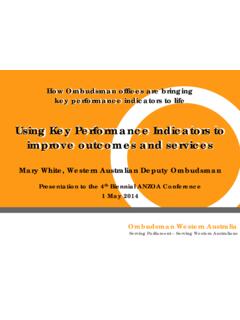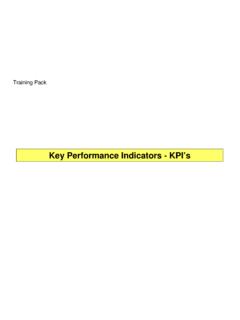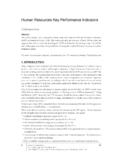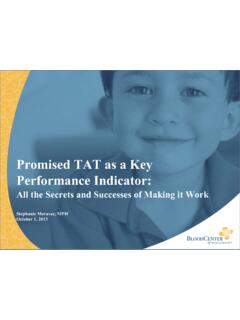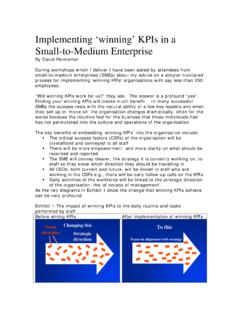Transcription of Key performance indicators A track record of discipline
1 Further information05 06 07 08 06 07 08 >$1m >$5m >$10m6799951073891722402551962008 KongSingaporeKoreaOther Asia PacificIndiaMiddle East and Other South AsiaAfricaAmericas, UK and EuropeNormalised earnings per shareThis key performance indicator (KPI) is calculated as profit attributable to ordinary shareholders of the Group as normalised for certain one-off or irregular items, divided by the weighted average of the number of shares in issue during the This measure is reported in the Group s audited financial statements within note return on shareholders equityNormalised return on shareholders equity is calculated as the normalised profit attributable to ordinary shareholders as a percentage of average ordinary shareholders This measure is derived from information within the Group s audited financial statements, being normalised earnings (note 13) as a percentage of average shareholders equity (excluding preference shares).
2 20072008200910 Standard Chartered Annual Report performance indicatorsA track record of disciplineAim To deliver consistent year on year growth in normalised earnings per During 2009, normalised earnings per share grew percent. Aim To deliver mid-teen returns whilst balancing the long term objective of having strong yet efficient levels of The normalised return on shareholders equity was per cent, down from per cent reflecting the further strengthening of our capital position. Aim To deliver diversified income Our income stream is highly diversified with five of our individual markets now delivering over $1 billion To grow the total number of relationships which deliver revenues in excess of $1 million, $5 million and $10 As we achieve core bank status, relationships increasingly become multi-country and multi-product resulting in growth of total global revenues.
3 We have increased the number of leading clients that generate revenues in excess of $1 million per year, demonstrating strong progress against our Wholesale Banking strategy of becoming the core bank to more To increase customer satisfaction with the products and services provided by Consumer Our 2008 score was impacted by negative customer sentiment, due to the global economic recession, especially in relation to investment earnings. This year, NPS recovered to double the 2008 earnings per return on shareholders income by region (%) 2009 Wholesale Banking clientsConsumer Banking Net Promoter Score (NPS) be the world s best international bankFocusing on Asia, Africa and the Middle EastBuilding long-term, deep relationships with our clients and customersThe marks Net Promoter , NPS , and Net Promoter Score as referred to in the reports are trademarks of Satmetrix Systems, Inc.
4 , Bain & Company, and Fred 06 07 08 * 06 07 08 096,8618,62011,06713,96815, 06 07 08 09 Further informationOperating income by regionSource This information is discussed in note 2 segmental information on page Banking clientsThis metric charts our progress towards becoming the core bank to our clients by measuring the number of client relationships where total global revenues exceed the threshold amount. The bar chart shows growth in Wholesale Banking clients over a two-year period. 2008 data did not include client revenues from American Express Bank (AEB), which we acquired that year. Now AEB is fully integrated into our organisation, 2009 data includes AEB and 2008 data has been restated Standard Chartered client Banking Net Promoter Score (NPS) IndexNet Promoter Score (NPS) replaces the Loyal and Positive Index as the non-financial KPI of Consumer Banking.
5 This supports the shift in our Consumer Banking strategy towards greater customer focus. NPS gauges customer support for the Consumer Banking products and services we provide. Customers are asked how likely they would be to recommend us to their friends and colleagues. NPS is the difference between the percentage of promoters (those who are highly likely to recommend) and percentage of detractors (those who are unlikely to recommend). It operates on a scale from -100 (all detractors) to +100 (all promoters).NPS is recognised as the ultimate measure of customer advocacy across many industry sectors including banking. By recognising the positive impact of advocates and the cost of poor service (detractors deducted from advocates), it can provide a good indication of future business outcomes in terms of market Market Probe Customer Satisfaction Survey (~20 markets on average each year).
6 The survey uses interviews completed in the second half of 1 capital ratioTier 1 capital, the components of which are summarised on page 70, is measured by the ratio of Tier 1 capital to risk weighted assets.* Restated and explained on page This measure is reported in theCapital section on page incomeOperating income is calculated as the sum of the net interest income, net fees and commission income, net trading income, and other operating income. Source This measure is reported in the Group s audited financial staff engagement ratioThe ratio identifies the proportion of our staff who responded positively to the survey items. The average engagement figure quoted is the Q12 Grand Mean; the average score of all our staff to 12 highly researched questions that differentiate high performing from low performing teams.
7 Over the last year this has become the primary measure of engagement we use The Gallup Organisation, Q12 Employee Engagement Chartered Annual Report 200911 Business reviewContinuing to run our balance sheet conservativelyFocusing on organic growth as the primary driver of value creationContinuing to nurture and reinforce our distinctive cultureTier 1 capital income$15,184mQ12 staff engagement :1 Aim To maintain a strong capital base, targeting a Tier 1 capital ratio within a range of 7 to 9 per cent. Analysis In 2009, our Tier 1 ratio was per cent, well above our stated target range, with a strong capital position further strengthened by strong organic equity generation and an additional issue of shares.
8 In light of the uncertain economic and regulatory environment, we consider it appropriate to remain strongly capitalised above our target To sustain organic momentum within growing Operating income grew by $1,216 million, or 9 per cent, to $15,184 million from diverse streams across products and To foster a culture of high employee engagement as we continue to grow and In a turbulent year for the industry, we maintained a strong employee engagement ratio at :1. Additionally, the grand mean engagement score increased from to on a 5 point scale.







